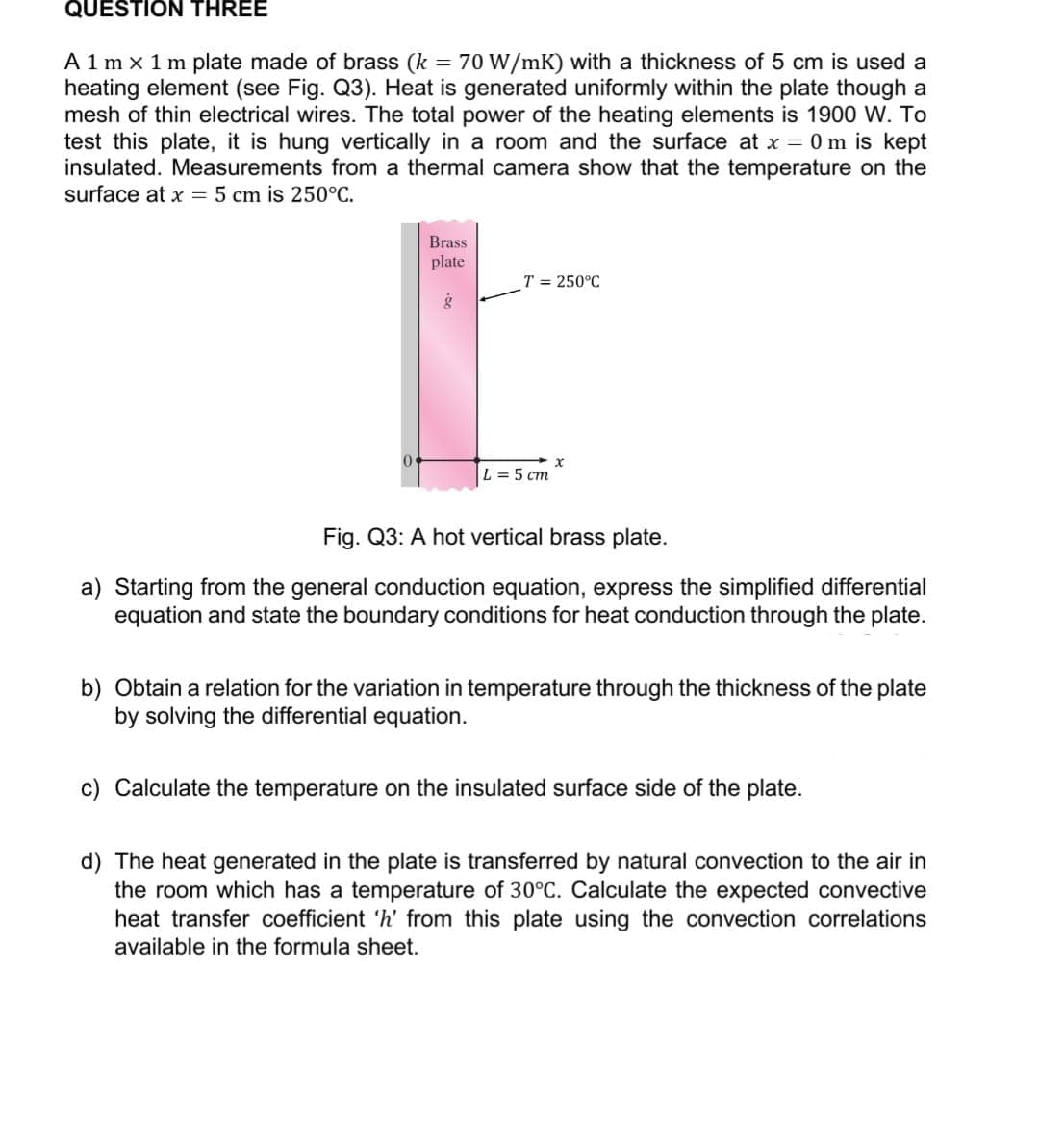A 1 m x 1 m plate made of brass (k = 70 W/mK) with a thickness of 5 cm is used a heating element (see Fig. Q3). Heat is generated uniformly within the plate though a mesh of thin electrical wires. The total power of the heating elements is 1900 W. To test this plate, it is hung vertically in a room and the surface at x = 0 m is kept insulated. Measurements from a thermal camera show that the temperature on the surface at x = 5 cm is 250°C. Brass plate T = 250°C L =5 cm Fig. Q3: A hot vertical brass plate. a) Starting from the general conduction equation, express the simplified differential equation and state the boundary conditions for heat conduction through the plate. b) Obtain a relation for the variation in temperature through the thickness of the plate by solving the differential equation. c) Calculate the temperature on the insulated surface side of the plate.
A 1 m x 1 m plate made of brass (k = 70 W/mK) with a thickness of 5 cm is used a heating element (see Fig. Q3). Heat is generated uniformly within the plate though a mesh of thin electrical wires. The total power of the heating elements is 1900 W. To test this plate, it is hung vertically in a room and the surface at x = 0 m is kept insulated. Measurements from a thermal camera show that the temperature on the surface at x = 5 cm is 250°C. Brass plate T = 250°C L =5 cm Fig. Q3: A hot vertical brass plate. a) Starting from the general conduction equation, express the simplified differential equation and state the boundary conditions for heat conduction through the plate. b) Obtain a relation for the variation in temperature through the thickness of the plate by solving the differential equation. c) Calculate the temperature on the insulated surface side of the plate.
Principles of Heat Transfer (Activate Learning with these NEW titles from Engineering!)
8th Edition
ISBN:9781305387102
Author:Kreith, Frank; Manglik, Raj M.
Publisher:Kreith, Frank; Manglik, Raj M.
Chapter2: Steady Heat Conduction
Section: Chapter Questions
Problem 2.30P: 2.30 An electrical heater capable of generating 10,000 W is to be designed. The heating element is...
Related questions
Question
Please i need hand written solution on pages in 60 mins i will give you positive feedback

Transcribed Image Text:QUESTION THREE
A 1 m x 1 m plate made of brass (k = 70 W/mK) with a thickness of 5 cm is used a
heating element (see Fig. Q3). Heat is generated uniformly within the plate though a
mesh of thin electrical wires. The total power of the heating elements is 1900 W. To
test this plate, it is hung vertically in a room and the surface at x = 0 m is kept
insulated. Measurements from a thermal camera show that the temperature on the
surface at x = 5 cm is 250°C.
Brass
plate
T = 250°C
L = 5 cm
Fig. Q3: A hot vertical brass plate.
a) Starting from the general conduction equation, express the simplified differential
equation and state the boundary conditions for heat conduction through the plate.
b) Obtain a relation for the variation in temperature through the thickness of the plate
by solving the differential equation.
c) Calculate the temperature on the insulated surface side of the plate.
d) The heat generated in the plate is transferred by natural convection to the air in
the room which has a temperature of 30°C. Calculate the expected convective
heat transfer coefficient 'h' from this plate using the convection correlations
available in the formula sheet.
Expert Solution
This question has been solved!
Explore an expertly crafted, step-by-step solution for a thorough understanding of key concepts.
Step by step
Solved in 2 steps

Knowledge Booster
Learn more about
Need a deep-dive on the concept behind this application? Look no further. Learn more about this topic, mechanical-engineering and related others by exploring similar questions and additional content below.Recommended textbooks for you

Principles of Heat Transfer (Activate Learning wi…
Mechanical Engineering
ISBN:
9781305387102
Author:
Kreith, Frank; Manglik, Raj M.
Publisher:
Cengage Learning

Principles of Heat Transfer (Activate Learning wi…
Mechanical Engineering
ISBN:
9781305387102
Author:
Kreith, Frank; Manglik, Raj M.
Publisher:
Cengage Learning